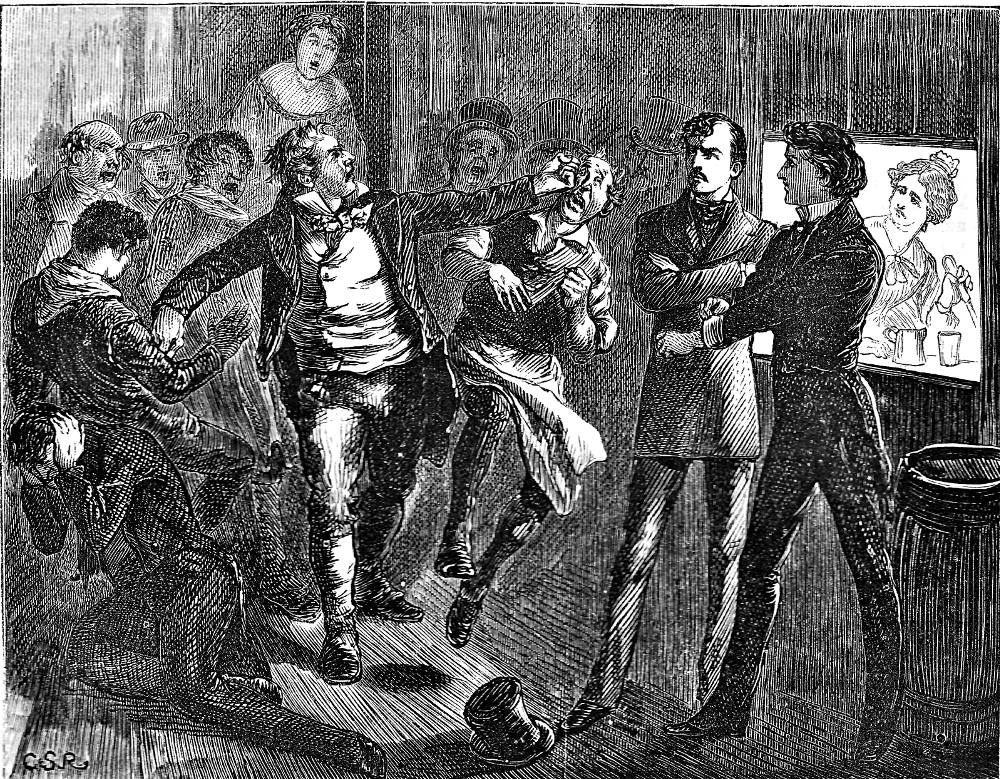
"I say," said John, rather astounded for the moment, "mak' theself quite at whoam, will 'ee?", for Chap. XLII; thirty-ninth illustration for the British Household Edition, illustrated by Fred Barnard with fifty-nine composite woodblock engravings (1875). The framed illustration is 10.7 cm high by 13.7 cm wide (4 ¼ by 5 ⅜ inches), p. 277. Running head: "Renewal of an Old Acquaintance" (275). [Click on the images to enlarge them.]
Passage Illustrated: Nicholas salutes John Browdie's Bride
Quite forgetting even his hunger in the heartiness of his salutation, John Browdie shook Nicholas by the hand again and again, slapping his palm with great violence between each shake, to add warmth to the reception.
"Ah! there she be," said John, observing the look which Nicholas directed towards his wife. "There she be — we shan’t quarrel about her noo — eh? Ecod, when I think o’ thot — but thou want’st soom’at to eat. Fall to, mun, fall to, and for wa’at we’re aboot to receive —"
No doubt the grace was properly finished, but nothing more was heard, for John had already begun to play such a knife and fork, that his speech was, for the time, gone.
"I shall take the usual licence, Mr. Browdie," said Nicholas, as he placed a chair for the bride.
"Tak’ whatever thou like’st," said John, "and when a’s gane, ca’ for more."
Without stopping to explain, Nicholas kissed the blushing Mrs. Browdie, and handed her to her seat.
"I say," said John, rather astounded for the moment, "mak’ theeself quite at whoam, will ‘ee?" [Chapter XLII, "Illustrative of the convivial Sentiment, that the best of Friends must sometimes part," 274]
Commentary
Barnard foils two of his favourite elements: a comic scene involving eating and drinking at an inn with a more tender emotion. In this breakfast scene, Nicholas gives Tilda Browdie a chaste kiss to acknowledge her recent marriage to the genial Yorkshireman. John, enjoying a large repast, is only moderately shocked at Nicholas's making himself at home with his bride, the formeer Matilda Price as Nicholas knew her when he worked as an usher at Wackford Squeers' Yorkshire boarding school near Greta Bridge. Thus, Barnard fuses Dickens's method of alternating sentimental and comic scenes ("the "streaky bacon" method of plot construction) in a single scene, both tender and humorous.
Parallel Scene of Nicholas and John Browdie with Frank Cheeryble from the American Household Edition

Above: C. S. Reinhart's turbulent scene when John Browdie intervenes to save Frank Cheeryble after the breakfast scene at the inn: Falling about in all directions, now to the right, now to the left in Chapter 43 (1875).
Related material, including front matter and sketches, by other illustrators
- Nicholas Nickleby (homepage)
- Phiz's 38 monthly illustrations for the novel, April 1838-October 1839.
- Cover for monthly parts
- Charles Dickens by Daniel Maclise, engraved by Finden
- "Hush!" said Nicholas, laying his hand upon his shoulder. (Vol. 1, 1861)
- The Rehearsal (Vol. 2, 1861)
- "My son, sir, little Wackford. What do you think of him, sir?" (Vol. 3, 1861)
- Newman had caught up by the nozzle an old pair of bellows . . . (Vol. 4, 1861).
- Sol Eytinge, Jr.'s 18 Illustrations for the Diamond Edition (1867)
- C. S. Reinhart's 52 Illustrations for the American Household Edution (1875)
- Harry Furniss's 29 illustrations for Nicholas Nickleby in the Charles Dickens Library Edition (1910)
- Kyd's four Player's Cigarette Cards (1910).
Scanned image, colour correction, sizing, caption, and commentary by Philip V. Allingham. [You may use this image without prior permission for any scholarly or educational purpose, as long as you (1) credit the person who scanned the image, and (2) link your document to this URL in a web document or cite the Victorian Web in a print one.]
Bibliography
Barnard, J. "Fred" (il.). Charles Dickens's Nicholas Nickleby, with fifty-nine illustrations. The Works of Charles Dickens: The Household Edition. 22 vols. London: Chapman and Hall, 1875. XV. Rpt. 1890.
Bentley, Nicolas, Michael Slater, and Nina Burgis. The Dickens Index. Oxford and New York: Oxford U. P., 1988.
Davis, Paul. Charles Dickens A to Z: The Essential Reference to His Life and Work. New York: Facts On File, 1998.
Dickens, Charles. The Life and Adventures of Nicholas Nickleby. With fifty-two illustrations by C. S. Reinhart. The Household Edition. New York: Harper & Brothers, 1872. I.
__________. Nicholas Nickleby. With 39 illustrations by Hablot K. Browne ("Phiz"). London: Chapman & Hall, 1839.
__________. Nicholas Nickleby. Illustrated by Harry Furniss. The Charles Dickens Library Edition. 18 vols. London: Educational Book, 1910. Vol. 4.
__________. "Nicholas Nickleby." Scenes and Characters from the Works of Charles Dickens, being eight hundred and sixty-six drawings by Fred Barnard et al.. Household Edition. London: Chapman and Hall, 1908.
Created 6 September 20211